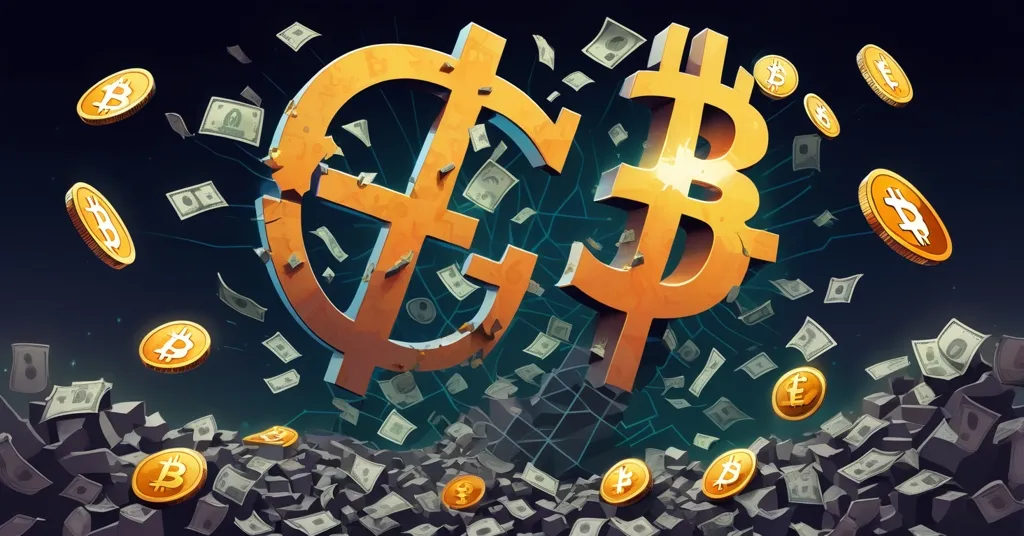US Dollar Surges to Two-Month High: Is Bitcoin Ready to Challenge Fiat Dominance?

US Dollar Roars to Two-Month High as Global Economies Stumble—Is This Bitcoin’s Moment?
The US dollar is staging a fierce comeback, smashing to a near two-month high while economic malaise and political chaos in Europe and Asia hammer major G10 currencies. With the Bloomberg Dollar Spot Index up 0.2%, edging close to its strongest since August, the dollar stands as the ultimate safe-haven asset in a world of uncertainty. But could this be the spark Bitcoin needs to shine as a true alternative, or a warning of rough seas ahead for crypto markets?
- Dollar Powerhouse: US dollar hits two-month peak amid global economic fears.
- Fiat Fallout: Euro, yen, and New Zealand dollar crumble under political and financial strain.
- Systemic Cracks: IMF flags serious risks in the $10 trillion daily foreign exchange market.
Dollar’s Unshakable Grip: Why It’s Happening
Let’s break this down. The dollar’s resurgence from a two-year low in September isn’t just a blip—it’s a loud signal of global jitters outside the US. Investors are piling into the greenback, seeing it as a fortress while currencies like the euro, Japanese yen, and New Zealand dollar (often nicknamed the “kiwi”) bleed value. For those new to the game, the Bloomberg Dollar Spot Index is a key benchmark that tracks the dollar’s muscle against a basket of major global currencies, and its 0.2% climb shows just how much trust is flowing into the US currency right now.
In Europe, the euro is taking a beating thanks to political mayhem in France’s parliament. Lawmakers are locked in dysfunction, spooking investors and tanking confidence in the Eurozone’s stability—a recurring nightmare since the debt crises over a decade ago. Meanwhile, in Asia, the yen is slipping as rumors swirl that Japan’s potential new prime minister might delay interest rate hikes and pump up government spending, essentially making money cheaper to borrow at a time when others are jacking up rates to fight inflation. Down under, the kiwi has nosedived to a six-month low after the Reserve Bank of New Zealand slashed rates more than expected and signaled even deeper cuts to rescue a sagging economy. These aren’t just isolated moves; they’re symptoms of a world economy on edge, as highlighted by reports on the US dollar reaching a two-month high amid weak growth in Europe and Asia.
The dollar’s dominance isn’t just about numbers—it’s a psychological anchor. The International Monetary Fund (IMF) dropped a bombshell in its latest Global Financial Stability Report, noting that a staggering $10 trillion moves through the foreign exchange market every single day. That’s roughly the combined GDP of several major economies, traded in just 24 hours. When financial panic hits, as it did at the start of COVID-19 in March 2020, non-US residents ramp up dollar purchases by a whopping 24 percentage points. The IMF puts it bluntly:
“Dollar purchases by non-U.S. residents tend to increase by 24 percentage points following a sharp spike in financial uncertainty.”
That’s not just a trend; it’s a stampede to safety. The dollar isn’t just a currency—it’s the world’s go-to shield when everything else feels like it’s burning down.
Forex Market Instability: A Ticking Time Bomb
But here’s where it gets ugly. The IMF isn’t just praising the dollar’s strength; it’s sounding the alarm on “heightened instability” in forex markets. Nonbank financial institutions (NBFIs)—think hedge funds, insurers, or other big money players that aren’t traditional banks—play a dual role. They grease the wheels during calm times but throw gasoline on the fire during crises, amplifying market chaos. Then throw in operational nightmares like tech outages, cyberattacks, and settlement delays, and you’ve got a system teetering on the brink. Emerging markets are getting squeezed hardest, grappling with dollar liquidity shortages and skyrocketing costs to protect against currency drops, which in turn jack up bond yields and rattle stock markets.
Hedge funds in Asia are smelling blood, snapping up put options to bet against weaker currencies like the euro and yen. In plain terms, they’re gambling that these currencies will tank further, a sign of just how shaky confidence has become. The IMF’s solution? They’re pushing for tighter oversight and better systems, stating:
“Comprehensive surveillance, stronger safeguards, and modernized platforms can reduce risk, enhance efficiency, and better position foreign exchange markets to support global finance.”
Translation: the old financial plumbing is rusting out, and it’s time for an overhaul. But let’s be real—centralized systems have been playing whack-a-mole with these issues for decades, patching holes while new leaks spring up. Meanwhile, Bitcoin just keeps hashing along, unbothered by parliamentary squabbles or central bank blunders.
Crypto’s Response to Dollar Dominance: Opportunity or Obstacle?
So, what does a roaring dollar mean for Bitcoin and the wider crypto space? On one hand, a strong dollar often screams distrust in other fiat systems, especially in emerging markets where currency devaluation and liquidity crunches hit like a freight train. Bitcoin, frequently hailed as “digital gold,” has a track record of gaining traction in these environments as a hedge against fiat volatility. Look at historical moments—during the 2020 dollar spike amid COVID panic, Bitcoin started its climb, eventually rocketing to $69,000 by late 2021 as a crisis store of value. In countries like Venezuela or Nigeria, where local currencies collapse under inflation or capital controls, Bitcoin adoption often spikes as a lifeline.
But there’s a nasty flip side. When the dollar reigns as the ultimate safe bet, riskier assets like cryptocurrencies can get shoved to the sidelines. Investors craving safety might dump speculative holdings, including Bitcoin, for the guaranteed stability of the greenback. Back in 2018, during a dollar rally tied to US rate hikes, Bitcoin languished below $6,000 as capital fled to safety. Short-term liquidity crunches in risk markets can also drag crypto valuations down, and if fiat systems feel threatened by capital flight to decentralized alternatives, don’t be surprised if regulators tighten the screws. It’s a brutal tug-of-war—Bitcoin’s long-term promise as a borderless, censorship-resistant asset versus the short-term gravitational pull of the dollar’s iron fist.
Political chaos in major economies only sweetens Bitcoin’s pitch. France’s parliamentary mess and Japan’s policy uncertainty erode trust in fiat, making a case for a currency that doesn’t bow to government whims. Even New Zealand’s desperate rate cuts signal economic distress that could nudge yield-hungry investors toward crypto, though broader market turbulence might cap any gains for now. And let’s cut the crap—anyone spouting definitive price predictions for Bitcoin based on this dollar surge is likely full of hot air. We’re not here for shilling or crystal ball nonsense; we’re here to dissect the fundamentals and think critically about what’s next.
Decentralization as the Answer: Blockchain’s Big Moment
The IMF’s warnings about forex weaknesses aren’t just academic gripes—they’re a glaring neon sign pointing to the flaws in centralized finance. This is precisely why Bitcoin was born: to sidestep the vulnerabilities of systems riddled with operational risks and middlemen. Blockchain technology offers a tangible way out. Unlike traditional forex platforms prone to settlement failures or cyberattacks, blockchain-based systems enable near-instant, transparent cross-border transactions. Projects like RippleNet aim to overhaul payments with faster, cheaper transfers, while Chainlink’s decentralized oracles could provide tamper-proof data for currency trades, slashing the risks of manipulation or outages.
Zooming out, decentralized finance (DeFi) platforms on Ethereum are carving out a niche as alternatives for hedging currency risk without relying on creaky legacy infrastructure. Smart contracts can automate trades or insurance against fiat drops, cutting out the NBFIs that the IMF warns amplify market chaos. Sure, DeFi isn’t perfect—scalability hiccups and regulatory gray zones persist—but it’s a hell of a lot sturdier than a system that chokes on a single tech glitch. And while Bitcoin maximalists like myself see BTC as the ultimate store of value, I’ll tip my hat to altcoins filling critical gaps. Solana’s lightning-fast transactions could power micro-payments across borders, and Polkadot’s interoperability might one day link disparate forex systems into a cohesive, decentralized web. These innovations aren’t distractions; they’re complementary pieces of a financial revolution.
Yet, let’s not get carried away with utopian dreams. Adoption isn’t a straight line—crypto faces its own battles with usability, energy debates (yes, Bitcoin mining still draws flak), and the psychological barrier of trusting code over cash. A dollar-dominated world also means global liquidity often hinges on US policy. If the Fed tightens further or geopolitical shocks spike dollar demand, crypto could face headwinds as capital sticks to the “safe” bet. Still, every crack in the fiat facade—be it a cyberattack on forex systems or a central bank fumble—is another argument for decentralization’s inevitability.
Key Questions for Crypto Enthusiasts
- How Does a Strong US Dollar Affect Bitcoin Adoption Worldwide?
A dominant dollar can fuel interest in Bitcoin as a decentralized hedge, especially in emerging markets hit by currency devaluation and liquidity shortages, though it risks siphoning capital from speculative assets in the short term. - Can Blockchain Fix Foreign Exchange Market Weaknesses?
Absolutely—blockchain settlement systems promise faster, transparent cross-border transactions, dodging the operational failures and delays that plague traditional forex platforms as highlighted by the IMF. - Are Centralized Financial Systems Too Risky Compared to Decentralized Options?
The IMF’s red flags on NBFI-driven instability and tech vulnerabilities in forex markets scream yes, making DeFi on platforms like Ethereum a compelling alternative for managing financial risk. - How Does Political Chaos in Major Economies Boost Bitcoin’s Appeal?
Turmoil in France and policy uncertainty in Japan erode faith in fiat currencies, positioning Bitcoin as a borderless, government-independent store of value that thrives when trust in systems falters. - What Do Central Bank Rate Cuts Mean for Crypto Markets?
Cuts like New Zealand’s signal economic pain, potentially driving investors to crypto for yield, but widespread instability could weigh on valuations until broader confidence returns.
Stepping back, the dollar’s surge is both a challenge and a golden opportunity for crypto. It exposes the rotting underbelly of centralized finance—exactly the kind of mess Bitcoin and blockchain tech were built to disrupt. As champions of decentralization, we see the IMF’s warnings as a battle cry. The outdated fiat system clings to power, but its days are numbered as crypto gains ground. Bitcoin might not dethrone the greenback tomorrow, and altcoins like Ethereum or Solana are vital for filling niches BTC doesn’t touch, but together, they’re forging a future where money doesn’t crumble under political missteps or cyber breaches.
So, while the dollar struts its stuff, let’s keep our eyes on the real prize: a decentralized world that laughs in the face of fiat’s flaws. If this surge keeps exposing centralized failures, could 2025 be the year Bitcoin starts chipping away at the greenback’s throne as the world’s reserve currency—or are we still decades from that upheaval? One thing’s for damn sure—the fight for financial freedom is just heating up, and we’re all in for the ride.



